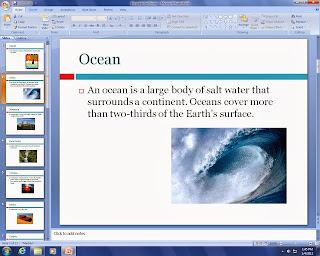| Landform list for PowerPoint project | |
| Archipelago | An archipelago is a group or chain of islands clustered together in a sea or ocean. |
| Atoll | An atoll is a ring (or partial ring) of coral that forms an island in an ocean or sea. The coral sits stop a submerged volcanic cone. |
| Bay | A bay is a body of water that is partially enclosed by land. |
| Canyon | A canyon is a deep valley with very steep sides often carved from the earth by a river. |
| Cape | A cape is a pointed piece of land that sticks out into a sea, ocean, lake or river. |
| Cave | An underground enclosure accessed from the surface of the ground or from the sea. |
| Channel | A channel is a body of water that connects two larger bodies of water. A channel is also a part of a river or harbor that is deep enough to let ships sail through. |
| Cliff | A cliff is a steep face of rock and soil. |
| Cove | A cove is a small, horseshoe shaped body of water along the coast; the water is surrounded by land formed of soft rock. |
| Delta | A delta is a low, watery land formed at the mouth of a river. It is formed from the silt, sand and small rocks that flow downstream in the river and are deposited in the delta. |
| Desert | A desert is a very dry area. |
| Dune | A dune is a hill or ridge made of sand. Dunes are shaped by the wind and change all the time. |
| Estuary | An estuary is where a river meets the sea or ocean. |
| Fjord | A fjord is a long, narrow sea inlet that is bordered by steep cliffs. |
| Glacier | A glacier is a long-lasting, slowly moving river or ice on land. |
| Gulf | A gulf is a part of the ocean (or sea) that is partly surrounded by land (it is usually larger than a bay.) |
| Hill | A hill is a raised area or mound of land. |
| Island | An island is a piece of land that is surrounded by water. |
| Isthmus | An isthmus is a narrow strip of land connecting two larger landmasses. |
| Lake | A lake is a large body of water surrounded by land on all sides. Really huge lakes are often called seas. |
| Mountain | A mountain is a very tall high, natural place on Earth – higher than a hill. |
| Ocean | An ocean is a large body of salt water that surrounds a continent. Oceans cover more than two-thirds of the Earth’s surface. |
| Peninsula | A peninsula is a body of land that is surrounded by water on three sides. |
| Plain | Plains are flat lands that only have small changes in elevation. |
| Plateau | A plateau is a large, flat area of land that is higher than the surrounding land. |
| Pond | A pond is a small body of water surrounded by land. A pond is smaller than a lake. |
| Prairie | A prairie is a wide, relatively flat area of land that has grasses and only a few trees. |
| Rainforest | A forest that receives more than 8 feet of rain each year. |
| Reef | A submerged ridge of rock or coral near the surface of the water. |
| River | A river is a large, flowing body of water that usually empties into a sea or ocean. |
| Savanna | A savanna is a flat grassland in a tropical or subtropical region. |
| Sea | A sea is a large body of salty water that is often connected to an ocean. A sea may be partly or completely surrounded by land. |
| Strait | A strait is a narrow body of water that connects two larger bodies of water. |
| Swamp | A swamp is a type of freshwater wetland that has spongy, muddy land and a lot of water. Many trees and shrubs grow in swamps. |
| Valley | A valley is a low place between mountains. |
| Volcano | A volcano is a mountainous vent in the earth’s crust. When a volcano erupts, it spews out lava, ashes, and hot gases from deep inside the Earth. |
| Waterfall | When a river falls off steeply, there is a waterfall. |
| | |
Wednesday, January 4, 2012
Using PowerPoint to define and illustrate landforms
Learning about landforms is an important element of the 4th grade Social Studies class this month. So, in technology class this week and next, we will work on a PowerPoint slide show of selected landforms. The students were given a comprehensive list of landforms (see below), and were asked to decide which ones they would like to define and illustrate - using the ClipArt function of the program. The students worked from a template, but were welcomed to change the design, color and fonts. Below are a few of the first results - looking forward to seeing many more next week!
Subscribe to:
Post Comments (Atom)




A lot of people spell the word landforms as land forms. Landforms is a compound word and the two words are brought together.
ReplyDeleteList of Landforms